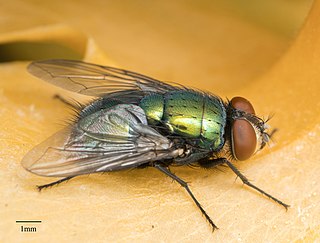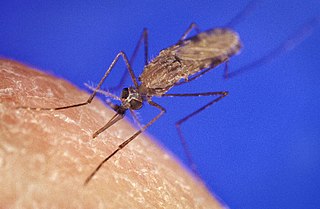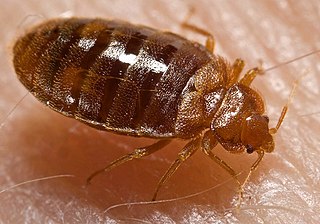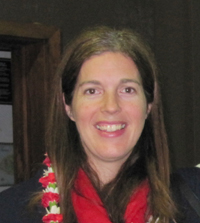Related Research Articles

Drosophila is a genus of flies, belonging to the family Drosophilidae, whose members are often called "small fruit flies" or pomace flies, vinegar flies, or wine flies, a reference to the characteristic of many species to linger around overripe or rotting fruit. They should not be confused with the Tephritidae, a related family, which are also called fruit flies ; tephritids feed primarily on unripe or ripe fruit, with many species being regarded as destructive agricultural pests, especially the Mediterranean fruit fly.

Mosquitoes, the Culicidae, are a family of small flies consisting of 3,600 species. The word mosquito is Spanish and Portuguese for little fly. Mosquitoes have a slender segmented body, one pair of wings, three pairs of long hair-like legs, and specialized, highly elongated, piercing-sucking mouthparts. All mosquitoes drink nectar from flowers; females of some species have in addition adapted to drink blood. Evolutionary biologists view mosquitoes as micropredators, small animals that parasitise larger ones by drinking their blood without immediately killing them. Medical parasitologists view mosquitoes instead as vectors of disease, carrying protozoan parasites or bacterial or viral pathogens from one host to another.

Flies are insects of the order Diptera, the name being derived from the Greek δι- di- "two", and πτερόν pteron "wing". Insects of this order use only a single pair of wings to fly, the hindwings having evolved into advanced mechanosensory organs known as halteres, which act as high-speed sensors of rotational movement and allow dipterans to perform advanced aerobatics. Diptera is a large order containing an estimated 1,000,000 species including horse-flies, crane flies, hoverflies, mosquitoes and others, although only about 125,000 species have been described.
A pheromone is a secreted or excreted chemical factor that triggers a social response in members of the same species. Pheromones are chemicals capable of acting like hormones outside the body of the secreting individual, to affect the behavior of the receiving individuals. There are alarm pheromones, food trail pheromones, sex pheromones, and many others that affect behavior or physiology. Pheromones are used by many organisms, from basic unicellular prokaryotes to complex multicellular eukaryotes. Their use among insects has been particularly well documented. In addition, some vertebrates, plants and ciliates communicate by using pheromones. The ecological functions and evolution of pheromones are a major topic of research in the field of chemical ecology.

Aedes albopictus, from the mosquito (Culicidae) family, also known as the (Asian) tiger mosquito or forest mosquito, is a mosquito native to the tropical and subtropical areas of Southeast Asia. In the past few centuries, however, this species has spread to many countries through the transport of goods and international travel. It is characterized by the white bands on its legs and body.

Various non-human animal species exhibit behavior that can be interpreted as homosexual or bisexual. This may include same-sex sexual activity, courtship, affection, pair bonding, and parenting among same-sex animal pairs. Various forms of this are found in every major geographic region and every major animal group. The sexual behavior of non-human animals takes many different forms, even within the same species, though homosexual behavior is best known from social species.

The common green bottle fly is a blowfly found in most areas of the world and is the most well-known of the numerous green bottle fly species. Its body is 10–14 mm (0.39–0.55 in) in length – slightly larger than a house fly – and has brilliant, metallic, blue-green or golden coloration with black markings. It has short, sparse, black bristles (setae) and three cross-grooves on the thorax. The wings are clear with light brown veins, and the legs and antennae are black. The larvae of the fly may be used for maggot therapy, are commonly used in forensic entomology, and can be the cause of myiasis in livestock and pets. The common green bottle fly emerges in the spring for mating.

Mosquito control manages the population of mosquitoes to reduce their damage to human health, economies, and enjoyment. Mosquito control is a vital public-health practice throughout the world and especially in the tropics because mosquitoes spread many diseases, such as malaria and the Zika virus.
Johnston's organ is a collection of sensory cells found in the pedicel of the antennae in the class Insecta. Johnston's organ detects motion in the flagellum. It consists of scolopidia arrayed in a bowl shape, each of which contains a mechanosensory chordotonal neuron. The number of scolopidia varies between species. In homopterans, the Johnston's organs contain 25 - 79 scolopidia. The presence of Johnston's organ is a defining characteristic which separates the class Insecta from the other hexapods belonging to the group Entognatha. Johnston's organ was named after the physician Christopher Johnston, father of the physician and Assyriologist Christopher Johnston.

The Mosquito or Mosquito alarm is a machine used to deter loitering by emitting sound at high frequency. In some versions, it is intentionally tuned to be heard primarily by younger people. Nicknamed "Mosquito" for the buzzing sound it plays, the device is marketed as a safety and security tool for preventing youths from congregating in specific areas.

The Anopheles gambiae complex consists of at least seven morphologically indistinguishable species of mosquitoes in the genus Anopheles. The complex was recognised in the 1960s and includes the most important vectors of malaria in sub-Saharan Africa, particularly of the most dangerous malaria parasite, Plasmodium falciparum. It is one of the most efficient malaria vectors known. The An. gambiae mosquito additionally transmits Wuchereria bancrofti which causes lymphatic filariasis, a symptom of which is elephantiasis.

Cimex is a genus of insects in the family Cimicidae. Cimex species are ectoparasites that typically feed on the blood of birds and mammals. Two species, Cimex lectularius and Cimex hemipterus, are known as bed bugs and frequently feed on humans, although other species may parasitize humans opportunistically. Species that primarily parasitize bats are known as bat bugs.

Leslie Birgit Vosshall is an American neurobiologist and currently a Howard Hughes Medical Institute (HHMI) investigator and the Robin Chemers Neustein Professor of Neurogenetics and Behavior at The Rockefeller University. In 2022 she was appointed Chief Scientific Officer and vice president of HHMI. She is also the director of the Kavli Neural Systems Institute at The Rockefeller University. Vosshall, a member of the National Academy of Sciences, is known for her contributions to the field of olfaction, particularly for the discovery and subsequent characterization of the insect olfactory receptor family, and the genetic basis of chemosensory behavior in mosquitoes. She has also extended her research into the study of human olfaction, revealing parts of human genetic olfactory architecture, and finding variations in odorant receptors that determine individuals’ abilities to detect odors.
Erica McAlister Hon.FRES is an entomologist, museum curator and presenter in the United Kingdom. She is an expert in flies (Diptera) and is senior curator at the Natural History Museum, London. She is a past President of the Amateur Entomologists' Society.

Elizabeth Nesta "Pat" Marks was an Australian entomologist who described 38 new mosquito species, as well as new species of fruit flies, bugs, cockroaches and ticks. She had a PhD in insect physiology from the University of Cambridge and was a member of the Royal Entomological Society of London.
Matthew (Matt) B. Thomas is an ecology professor and Huck Scholar in the Entomology Department at Pennsylvania State University in the United States. He is also affiliated with the Center for Infectious Disease Dynamics at Penn State.
Mariana Federica Wolfner is the Goldwin Smith Professor of molecular biology and genetics at Cornell University. Her research investigates sexual conflict in the fruit fly Drosophila melanogaster. She was elected a member of the National Academy of Sciences (NAS) in 2019 in recognition of her distinguished and continuing achievements in original research.

Aedes taeniorhynchus, or the black salt marsh mosquito, is a mosquito in the family Culicidae. It is a carrier for encephalitic viruses including Venezuelan equine encephalitis and can transmit Dirofilaria immitis. It resides in the Americas and is known to bite mammals, reptiles, and birds. Like other mosquitoes, Ae. taeniorhynchus adults survive on a combination diet of blood and sugar, with females generally requiring a blood meal before laying eggs.
Heather Margaret Ferguson FRSE, Professor of Medical Entomology and Disease Ecology, at Glasgow University; a specialist in researching mosquito vectors that spread malaria, in global regions where this is endemic, aiming to manage and control a disease which the World Health Organization estimates killed over 400,000 people in 2020. Ferguson co-chairs the WHO Vector Control Advisory Group and was elected as a Fellow of the Royal Society of Edinburgh in 2021.
References
- ↑ ORCID. "Gabriella Gibson (0000-0002-3127-8027)". orcid.org. Retrieved 16 December 2019.
- ↑ "Natural Resources Institute - Gabriella Gibson". www.nri.org. Retrieved 15 December 2019.
- ↑ "The Buzz on Mosquito Mating". Science | AAAS. 10 July 2006. Retrieved 15 December 2019.
- ↑ Fields, Helen (4 January 2010). "Mosquitoes: Love at First Buzz". Science | AAAS. Retrieved 15 December 2019.
- ↑ "To a mosquito, matchmaking means 'singing' in perfect harmony". ScienceDaily. Retrieved 15 December 2019.
- ↑ Deighton, Ben (28 July 2017). "'Breakthrough' mosquito trap uses human smell and heat". SciDev.net. Retrieved 15 December 2019.